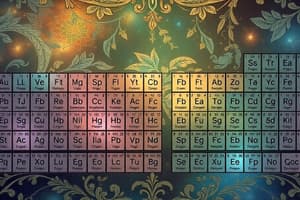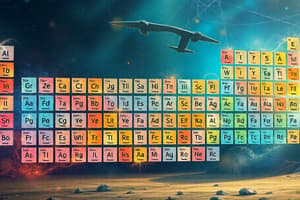Podcast
Questions and Answers
¿Dónde se encuentran típicamente los metales en la tabla periódica?
¿Dónde se encuentran típicamente los metales en la tabla periódica?
- En el centro
- En el lado derecho
- En el lado izquierdo (correct)
- No tienen una ubicación específica
¿Qué propiedad hace que los metales sean altamente reactivos?
¿Qué propiedad hace que los metales sean altamente reactivos?
- Tienden a perder electrones en sus capas más externas (correct)
- No tienen electrones en sus capas más externas
- Tienen una configuración electrónica estable
- Tienden a ganar electrones en sus capas más externas
¿Qué sucede con los elementos no metálicos en la tabla periódica?
¿Qué sucede con los elementos no metálicos en la tabla periódica?
- Se encuentran en el lado derecho
- Tienden a formar iones positivos
- Tienen menos electrones de los necesarios para una estructura de octeto estable (correct)
- Tienen más electrones de los necesarios para una estructura de octeto estable
¿Qué propiedad hace que los elementos no metálicos formen compuestos?
¿Qué propiedad hace que los elementos no metálicos formen compuestos?
¿Qué característica hace que el oro no reaccione con otros elementos en condiciones normales?
¿Qué característica hace que el oro no reaccione con otros elementos en condiciones normales?
¿Cuál es la definición correcta de un elemento químico?
¿Cuál es la definición correcta de un elemento químico?
¿Qué característica comparten los elementos dentro de un mismo grupo en la tabla periódica?
¿Qué característica comparten los elementos dentro de un mismo grupo en la tabla periódica?
¿Cuál de las siguientes afirmaciones sobre los períodos en la tabla periódica es correcta?
¿Cuál de las siguientes afirmaciones sobre los períodos en la tabla periódica es correcta?
¿Cuál de las siguientes características distingue a los metales de los no metales?
¿Cuál de las siguientes características distingue a los metales de los no metales?
¿Cuál de las siguientes afirmaciones sobre los elementos es correcta?
¿Cuál de las siguientes afirmaciones sobre los elementos es correcta?
Flashcards are hidden until you start studying
Study Notes
Periodic Table
The periodic table is a tabular arrangement of chemical elements, organized based on their atomic number, electron configuration, and recurring chemical properties. It provides a useful summary of data on elements' physical, chemical, and emotional properties. Here we will discuss the elements, groups, periods, metals, and nonmetals within this framework.
Elements
An element is a substance that cannot be broken down into simpler substances by chemical means alone. Each element consists of atoms which have different numbers of protons and electrons. These atomic properties determine an element's position on the periodic table. There are currently over 118 known elements, ranging from hydrogen (atomic number 1) to oganesson (atomic number 118).
Groups
The horizontal rows in the periodic table are called groups. Elements within each group show similarities in their electronic structures and physical, chemical, and emotional properties. For example, all elements in Group 1 are alkali metals, while those in Group 18 are noble gases.
Periods
Periods are the vertical columns in the periodic table. The elements within each period have approximately the same number of energy levels and thus exhibit similar chemical behavior. For instance, elements in Period 2 can form compounds with oxygen to make water using the appropriate number of electrons to obtain an octet configuration in their outer shells.
Metals
Metals are generally located in the left half of the periodic table. They tend to lose electrons in their outermost shells to achieve stable electron configurations, forming positive ions. This property makes metals highly reactive, allowing them to combine readily with other elements and form compounds. However, some metals like gold do not react with other elements under normal conditions due to their position in the periodic table nearer to the right half where they show less reactive tendencies.
Nonmetals
Nonmetals are typically found on the right side of the periodic table. They have fewer electrons than needed for a stable octet structure. As such, they tend to gain electrons from other atoms to achieve a full outer shell. This characteristic makes them form all kinds of compounds by forming negative ions or neutral molecules.
In conclusion, the periodic table is a powerful tool that helps us understand the relationships between different elements and how these relationships manifest in their properties. By understanding the positions of elements within this framework, we can predict their behavior in various reactions and applications.
Studying That Suits You
Use AI to generate personalized quizzes and flashcards to suit your learning preferences.




